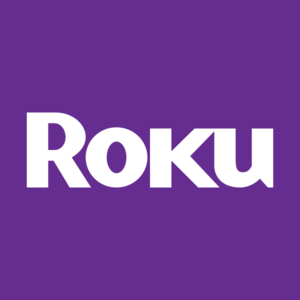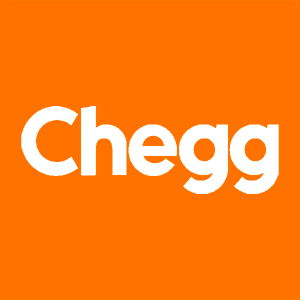
Match Group (MTCH)
Match Group catches our eye. Its stellar unit economics and marketing efficiency show its unique products generate organic demand.― StockStory Analyst Team
1. News
2. Summary
Why Match Group Is Interesting
Originally started as a dial-up service before widespread internet adoption, Match (NASDAQ:MTCH) was an early innovator in online dating and today has a portfolio of apps including Tinder, Hinge, Archer, and OkCupid.
- Successful business model is illustrated by its impressive EBITDA margin
- Powerful free cash flow generation enables it to reinvest its profits or return capital to investors consistently, and its growing cash flow gives it even more resources to deploy
- A drawback is its payers have declined by 4.7% annually over the last two years, suggesting it may need to revamp its features or user experience to stay competitive


Match Group shows some promise. If you’re a believer, the valuation seems reasonable.
Why Is Now The Time To Buy Match Group?
High Quality
Investable
Underperform
Why Is Now The Time To Buy Match Group?
At $33.59 per share, Match Group trades at 6.5x forward EV/EBITDA. Price is what you pay, and value is what you get. Considering this, we think the current valuation is quite a good deal.
If you think the market is not giving the company enough credit for its fundamentals, now could be a good time to invest.
3. Match Group (MTCH) Research Report: Q3 CY2025 Update
Dating app company Match (NASDAQ:MTCH) met Wall Streets revenue expectations in Q3 CY2025, with sales up 2.1% year on year to $914.3 million. On the other hand, next quarter’s revenue guidance of $870 million was less impressive, coming in 1.8% below analysts’ estimates. Its GAAP profit of $0.62 per share was 2.1% below analysts’ consensus estimates.
Match Group (MTCH) Q3 CY2025 Highlights:
- Revenue: $914.3 million vs analyst estimates of $914.3 million (2.1% year-on-year growth, in line)
- EPS (GAAP): $0.62 vs analyst expectations of $0.63 (2.1% miss)
- Adjusted EBITDA: $301 million vs analyst estimates of $333.2 million (32.9% margin, 9.7% miss)
- Revenue Guidance for Q4 CY2025 is $870 million at the midpoint, below analyst estimates of $885.7 million
- EBITDA guidance for Q4 CY2025 is $352.5 million at the midpoint, above analyst estimates of $341.2 million
- Operating Margin: 24.2%, in line with the same quarter last year
- Free Cash Flow Margin: 33.6%, up from 26.7% in the previous quarter
- Payers: 14.53 million, down 687,000 year on year
- Market Capitalization: $7.82 billion
Company Overview
Originally started as a dial-up service before widespread internet adoption, Match (NASDAQ:MTCH) was an early innovator in online dating and today has a portfolio of apps including Tinder, Hinge, Archer, and OkCupid.
These apps are used by millions globally to find love, friendship, or just a fun night out, although dating is the primary use case for consumers. The problem Match tries to address is simply that dating and finding love is hard, both logistically and emotionally. Specifically, meeting new people with shared interests, putting yourself out there, and trying to find someone you connect with can be a daunting task. Match provides a platform that facilitates connections while also filtering for practical aspects such as location and age.
Match generates revenue largely through paid subscriptions. Tinder and Hinge, the two highest revenue apps for Match, both offer free versions. However, users can access premium features through paid subscription tiers. For example, Tinder Plus gives users unlimited swipes and the option to change their location to connect with people in different cities. Hinge’s paid version allows users to see who has already liked their profile without needing to wait for a match, which can help save time and increase the probability of high-quality matches. The company also generates revenue through advertising, where brands can pay to have their products or services featured within the app.
4. Consumer Subscription
Consumers today expect goods and services to be hyper-personalized and on demand. Whether it be what music they listen to, what movie they watch, or even finding a date, online consumer businesses are expected to delight their customers with simple user interfaces that magically fulfill demand. Subscription models have further increased usage and stickiness of many online consumer services.
Competitors offering dating platforms include Bumble (NASDAQ:BMBL), Grindr (NYSE:GRND), and Spark Networks (NYSE:LOV), along with social networks where people can potentially make romantic connections like Snap (NYSE:SNAP) and Meta Platforms (NASDAQ:META).
5. Revenue Growth
A company’s long-term sales performance can indicate its overall quality. Any business can put up a good quarter or two, but the best consistently grow over the long haul. Unfortunately, Match Group’s 2.6% annualized revenue growth over the last three years was sluggish. This wasn’t a great result, but there are still things to like about Match Group.
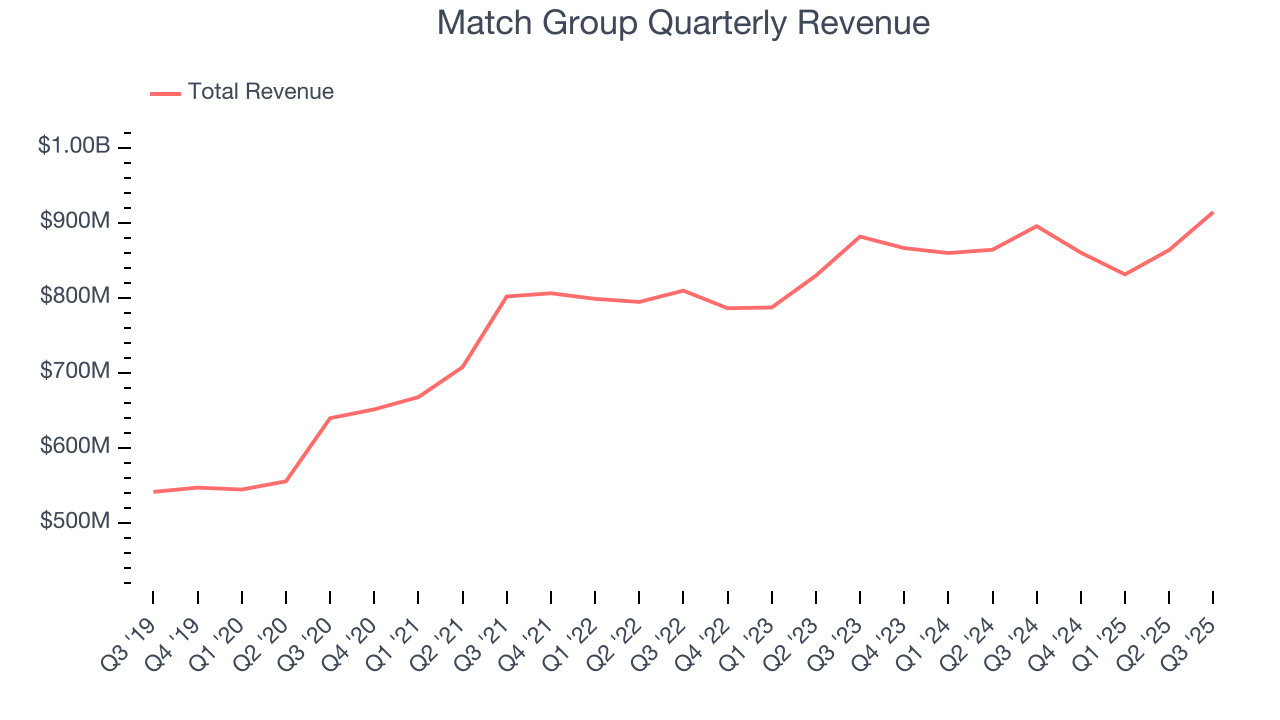
This quarter, Match Group grew its revenue by 2.1% year on year, and its $914.3 million of revenue was in line with Wall Street’s estimates. Company management is currently guiding for a 1.1% year-on-year increase in sales next quarter.
Looking further ahead, sell-side analysts expect revenue to grow 3.9% over the next 12 months, similar to its three-year rate. Although this projection suggests its newer products and services will spur better top-line performance, it is still below the sector average. At least the company is tracking well in other measures of financial health.
6. Payers
User Growth
As a subscription-based app, Match Group generates revenue growth by expanding both its subscriber base and the amount each subscriber spends over time.
Match Group struggled with new customer acquisition over the last two years as its payers have declined by 4.7% annually to 14.53 million in the latest quarter. This performance isn't ideal because internet usage is secular, meaning there are typically unaddressed market opportunities. If Match Group wants to accelerate growth, it likely needs to enhance the appeal of its current offerings or innovate with new products. 
In Q3, Match Group’s payers once again decreased by 687,000, a 4.5% drop since last year. The quarterly print isn’t too different from its two-year result, suggesting its new initiatives aren’t accelerating user growth just yet.
Revenue Per User
Average revenue per user (ARPU) is a critical metric to track because it measures how much the average user spends. ARPU is also a key indicator of how valuable its users are (and can be over time).
Match Group’s ARPU growth has been impressive over the last two years, averaging 7.9%. Although its payers shrank during this time, the company’s ability to successfully increase monetization demonstrates its platform’s value for existing users. 
This quarter, Match Group’s ARPU clocked in at $20.58. It grew by 6.9% year on year, faster than its payers.
7. Gross Margin & Pricing Power
A company’s gross profit margin has a significant impact on its ability to exert pricing power, develop new products, and invest in marketing. These factors can determine the winner in a competitive market.
For internet subscription businesses like Match Group, gross profit tells us how much money the company gets to keep after covering the base cost of its products and services, which typically include customer service, data center and infrastructure expenses, royalties, and other content-related costs if the company’s offerings include features such as video or music.
Match Group has robust unit economics, an output of its asset-lite business model and pricing power. Its margin is better than the broader consumer internet industry and enables the company to fund large investments in new products and marketing during periods of rapid growth to achieve higher profits in the future. As you can see below, it averaged an excellent 72.4% gross margin over the last two years. That means Match Group only paid its providers $27.61 for every $100 in revenue. 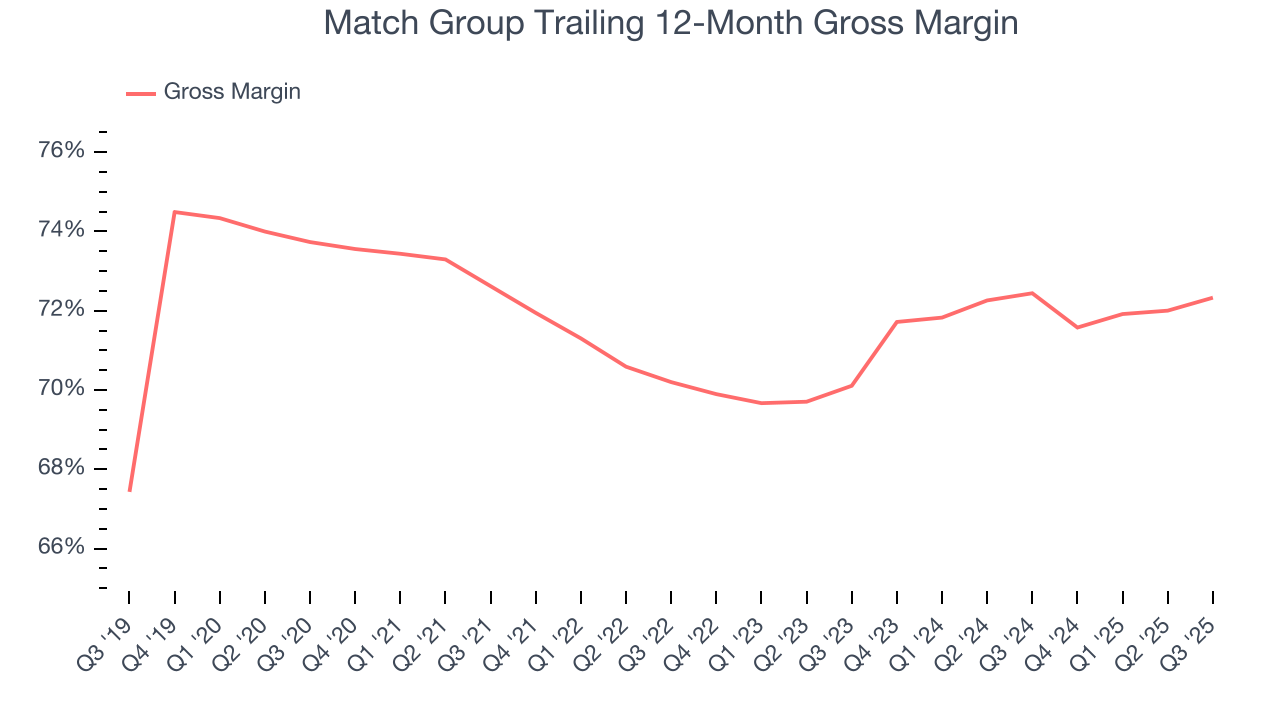
This quarter, Match Group’s gross profit margin was 73%, marking a 1.2 percentage point increase from 71.7% in the same quarter last year. Zooming out, the company’s full-year margin has remained steady over the past 12 months, suggesting its input costs have been stable and it isn’t under pressure to lower prices.
8. User Acquisition Efficiency
Unlike enterprise software that’s typically sold by dedicated sales teams, consumer internet businesses like Match Group grow from a combination of product virality, paid advertisement, and incentives.
Match Group is very efficient at acquiring new users, spending only 24.7% of its gross profit on sales and marketing expenses over the last year. This efficiency indicates that it has a highly differentiated product offering and strong brand reputation, giving Match Group the freedom to invest its resources into new growth initiatives while maintaining optionality. 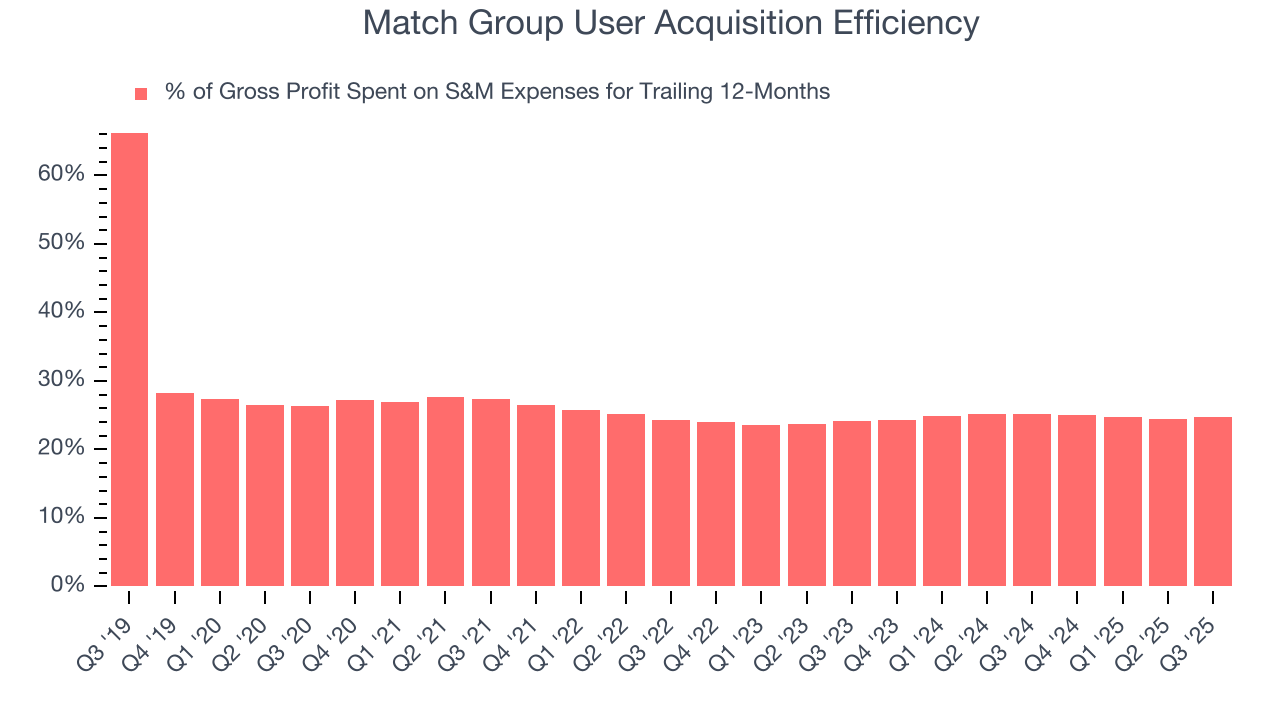
9. EBITDA
Operating income is often evaluated to assess a company’s underlying profitability. In a similar vein, EBITDA is used to analyze consumer internet companies because it excludes various one-time or non-cash expenses (depreciation), providing a clearer view of the business’s profit potential.
Match Group has been a well-oiled machine over the last two years. It demonstrated elite profitability for a consumer internet business, boasting an average EBITDA margin of 35.7%. This result isn’t surprising as its high gross margin gives it a favorable starting point.
Analyzing the trend in its profitability, Match Group’s EBITDA margin decreased by 1 percentage points over the last few years. This raises questions about the company’s expense base because its revenue growth should have given it leverage on its fixed costs, resulting in better economies of scale and profitability.
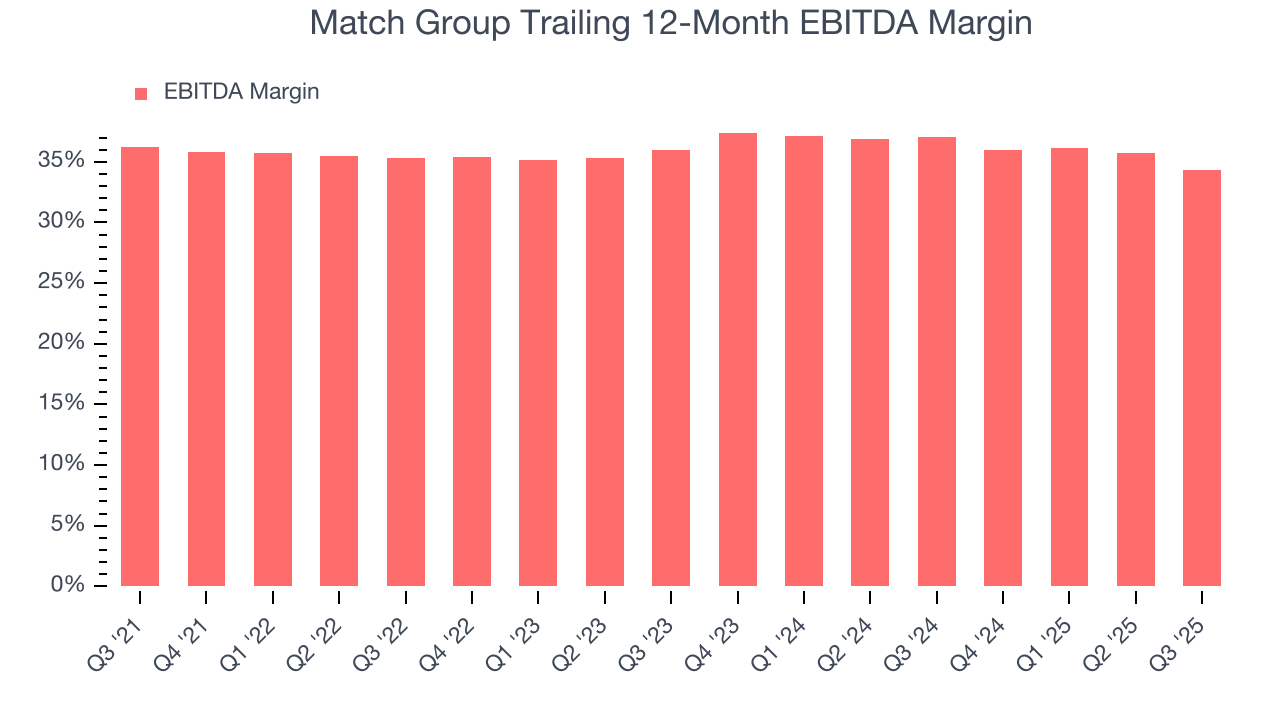
In Q3, Match Group generated an EBITDA margin profit margin of 32.9%, down 5.3 percentage points year on year. Conversely, its revenue and gross margin actually rose, so we can assume it was less efficient because its operating expenses like marketing, R&D, and administrative overhead grew faster than its revenue.
10. Earnings Per Share
Revenue trends explain a company’s historical growth, but the change in earnings per share (EPS) points to the profitability of that growth – for example, a company could inflate its sales through excessive spending on advertising and promotions.

We can take a deeper look into Match Group’s earnings quality to better understand the drivers of its performance. A three-year view shows that Match Group has repurchased its stock, shrinking its share count by 13.2%. This tells us its EPS outperformed its revenue not because of increased operational efficiency but financial engineering, as buybacks boost per share earnings. 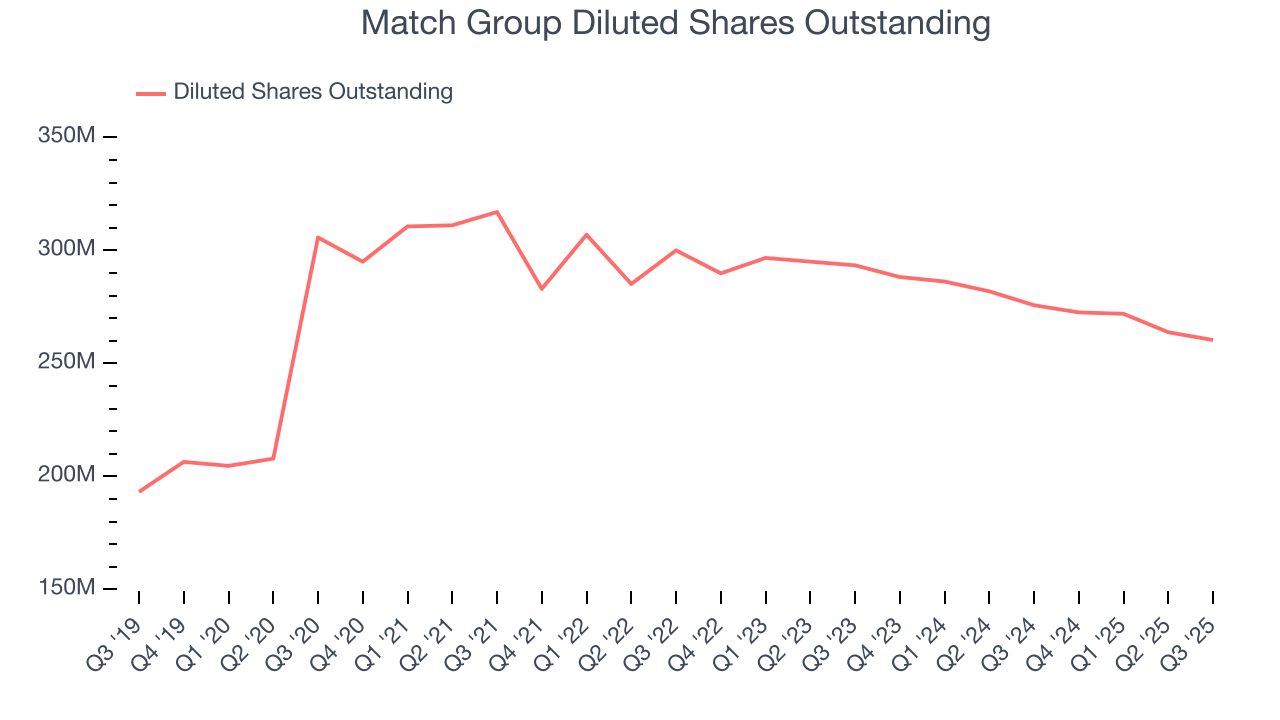
In Q3, Match Group reported EPS of $0.62, up from $0.49 in the same quarter last year. Despite growing year on year, this print missed analysts’ estimates, but we care more about long-term EPS growth than short-term movements. Over the next 12 months, Wall Street expects Match Group’s full-year EPS of $2.11 to grow 25.4%.
11. Cash Is King
Free cash flow isn't a prominently featured metric in company financials and earnings releases, but we think it's telling because it accounts for all operating and capital expenses, making it tough to manipulate. Cash is king.
Match Group has shown terrific cash profitability, driven by its lucrative business model and cost-effective customer acquisition strategy that enable it to stay ahead of the competition through investments in new products rather than sales and marketing. The company’s free cash flow margin was among the best in the consumer internet sector, averaging 26.7% over the last two years.
Taking a step back, we can see that Match Group’s margin expanded by 12.8 percentage points over the last few years. This is encouraging, and we can see it became a less capital-intensive business because its free cash flow profitability rose while its operating profitability fell.

Match Group’s free cash flow clocked in at $306.8 million in Q3, equivalent to a 33.6% margin. This result was good as its margin was 5.4 percentage points higher than in the same quarter last year, building on its favorable historical trend.
12. Balance Sheet Assessment
Match Group reported $1.06 billion of cash and $4.05 billion of debt on its balance sheet in the most recent quarter. As investors in high-quality companies, we primarily focus on two things: 1) that a company’s debt level isn’t too high and 2) that its interest payments are not excessively burdening the business.
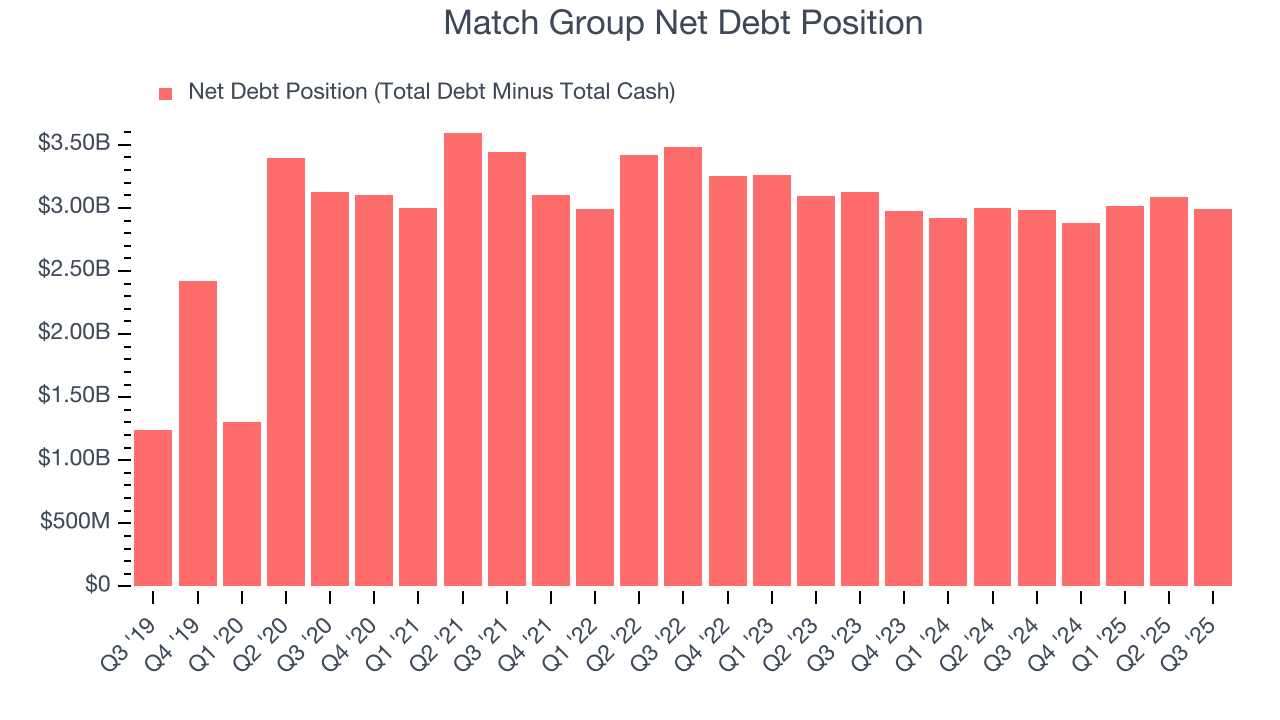
With $1.19 billion of EBITDA over the last 12 months, we view Match Group’s 2.5× net-debt-to-EBITDA ratio as safe. We also see its $52.86 million of annual interest expenses as appropriate. The company’s profits give it plenty of breathing room, allowing it to continue investing in growth initiatives.
13. Key Takeaways from Match Group’s Q3 Results
It was encouraging to see Match Group’s EBITDA guidance for next quarter beat analysts’ expectations. On the other hand, its revenue guidance for next quarter missed and its EBITDA fell short of Wall Street’s estimates. Overall, this quarter was mixed. The stock remained flat at $31.31 immediately after reporting.
14. Is Now The Time To Buy Match Group?
Updated: December 3, 2025 at 9:24 PM EST
Are you wondering whether to buy Match Group or pass? We urge investors to not only consider the latest earnings results but also longer-term business quality and valuation as well.
In our opinion, Match Group is a solid company. Although its revenue growth was weak over the last three years, its powerful free cash flow generation enables it to stay ahead of the competition through consistent reinvestment of profits. And while its users have declined, its impressive EBITDA margins show it has a highly efficient business model.
Match Group’s EV/EBITDA ratio based on the next 12 months is 6.5x. Looking at the consumer internet space right now, Match Group trades at a compelling valuation. For those confident in the business and its management team, this is a good time to invest.
Wall Street analysts have a consensus one-year price target of $37.32 on the company (compared to the current share price of $33.59), implying they see 11.1% upside in buying Match Group in the short term.






